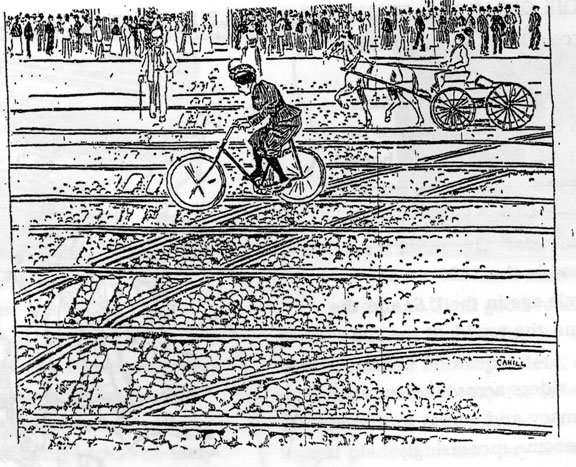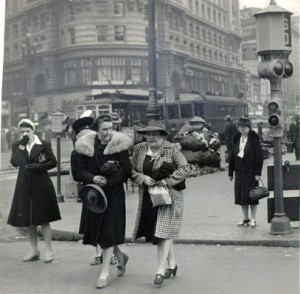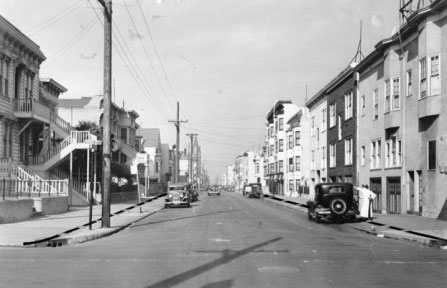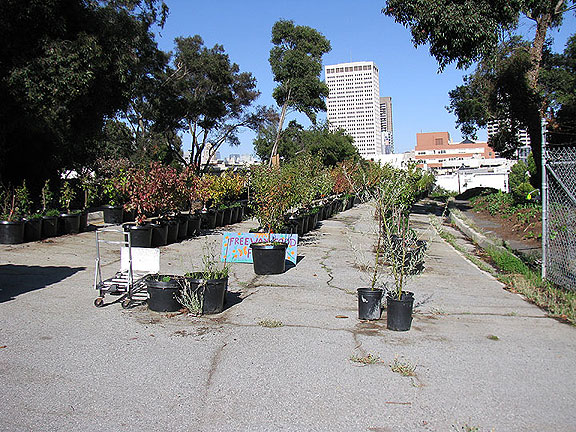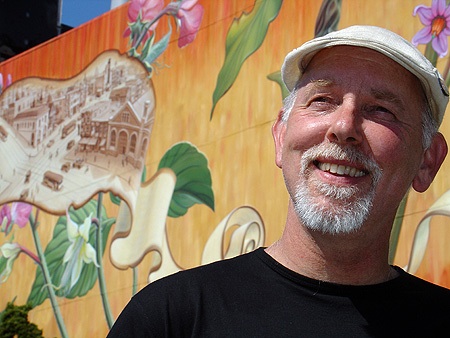[image_1_small]“Whose Streets? OUR Streets!” yell rowdy demonstrators when they surge off the sidewalk and into thoroughfares. True enough, the streets are our public commons, what’s left of it, but most of the time these public avenues are dedicated to the movement of vehicles, mostly privately owned autos. Other uses are frowned upon, discouraged by laws and regulations and what has become our “customary expectations.” Ask any driver who is impeded by anything other than a “normal” traffic jam and they’ll be quick to denounce the inappropriate use or blockage of the street.
We meet here at the “Towards Carfree Cities Conference” to address how cities are designed, with an overriding interest in redefining what is proper and customary with respect to how streets are used. Part of the emergence of social movements in cities around the world to contest the car, whether bicycling, pedestrians, or street closures, is in response to the seeming inevitability of cars dominating our public space. But automobiles didn’t always fill our streets.
Bicyclists have been working to make space on the streets of San Francisco for bicycling, and to do that they’ve been trying to reshape public expectations about how streets are used. Predictably there’s been a pushback from motorists and their allies, who imagine that the norms of mid-20th century American life can be extended indefinitely into the future. But cyclists and their natural allies, pedestrians, can take heart from a lost history that has been illuminated by Peter D. Norton in his recent book “Fighting Traffic: The Dawn of the Motor Age in the American City.” He skillfully excavates the shift that was engineered in public opinion during the 1920s by the organized forces of what called itself “Motordom.” Their efforts turned pedestrians into scofflaws known as “jaywalkers,” shifted the burden of public safety from speeding motorists to their victims, and reorganized American urban design around providing more roads and more space for private cars.
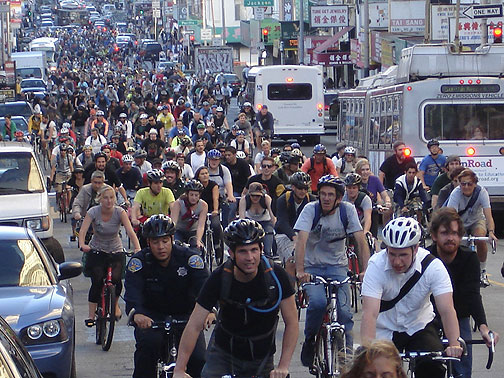 Critical Mass in San Francisco, August 2007.
Critical Mass in San Francisco, August 2007.
But before we look at how motor cars took over our thoroughfares and our imaginations, let us go further back into history, to the end of the 19th century. It was an era of horses, wagons, and streetcars, muddy streets and wooden sidewalks. Different kinds of self-propelled velocipedes and bicycles were invented in the 1870s and became massively popular in the 1890s with the invention of the safety bicycle. In San Francisco, and around the United States, a movement emerged primarily among bicyclists demanding “good roads.”
 In 1875 these "boneshakers" were all the rage.
In 1875 these "boneshakers" were all the rage.
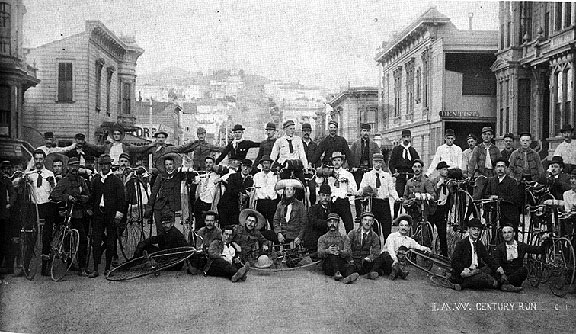 BayCity Wheelmen, 1894, in San Francisco's Mission District.
BayCity Wheelmen, 1894, in San Francisco's Mission District.
An 1896 newspaper illustration of the notoriously bad road conditions in San Francisco at the time.
On July 25, 1896, thousands of cyclists filled the streets in the largest demonstration seen in San Francisco’s history. In the last decade of the 19th century, San Francisco was a muddy, dirty town, long past its glory years as a boomtown, but still one of the ten largest cities in the U.S. The streets were full of horseshit and between the ubiquitous cable car slots and tangled web of streetcar rails, pedestrians and bicyclists had a hazardous course to traverse en route to their destinations. After months of organizing among the thriving bicycling clubs of the city, a huge parade was organized that drew as many as 100,000 spectators.
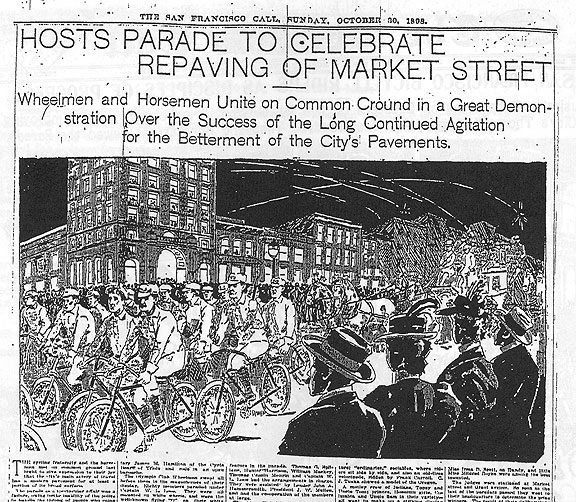 The "Good Roads' bike parade-protest of 1896.
The "Good Roads' bike parade-protest of 1896.
[image_3_big]Meanwhile, in 1900 an elegant bikeway was built along the Arroyo Seco corridor north of the Los Angeles River. It was the keystone of a plan to link Los Angeles and Pasadena with an eight-mile “great transit artery.” Pasadena Mayor Horace Dobbins dedicated public funds to an elevated, multilane, wooden cycleway, including streetlights and gazebo turnouts. The 15-cent toll didn’t dissuade hundreds of cyclists who showed up to the opening, going on to ride through a beautiful pre-urban Los Angeles landscape. More than 20 percent of the population were already regular bikers in 1900, and of course the weather was ideal. Cycleways were going to crisscross the area and provide a stylish and modern system for personal transport. As the 20th century unfolded, the automobile rushed into the picture. Within a few years bikeway expansion was scrapped and even the Arroyo Seco Cycleway was soon turned into a motorway (now it is better known as the Pasadena Freeway).
As thousands of Californians became motorists, patterns of city life began to change. The chaotic crisscrossing of pedestrians, horses and horse-drawn wagons, streetcars, cable cars, and steam railroads, already joined by increasing numbers of bicyclists, now saw an influx of private automobiles.
As city centers choked with traffic congestion, and automobile injuries and deaths soared, a struggle to reshape city streets took place. Police and parents wanted to control speeds to promote safety. Highway engineers wanted to widen and streamline city streets to promote through traffic at higher speeds. Auto companies promoted the “freedom of the open road” and claimed that street improvements must properly be directed to bettering driving conditions since most of the money for road building and maintenance was derived from gasoline taxes. Bicycles and pedestrians were the obvious losers in this era, as highway engineers—reinforced by auto industry propaganda—focused on widening streets, increasing parking, creating parkways and highways (later freeways), while society subtly shifted the blame for car-related fatalities to careless pedestrians and cyclists, or individual bad drivers.
Before cars entered the public streets, customary practice gave priority to people on foot. Going back for centuries, public roads were open to everyone and pedestrians enjoyed a type of seniority rights. Horse-drawn wagons, horse-drawn omnibuses or streetcars, and finally electrically powered streetcars moved thousands and then millions of people into and around the growing cities of the world.
The automobile quickly threw all the old patterns into disarray…
For decades, over 40,000 people have died each year in more than a million car crashes on the streets of the United States. This daily carnage is utterly normalized to the point that few of us think about it at all, and if we do, it’s like the weather, just a regular part of our environment. But it wasn’t always this way. Back when the private automobile was first beginning to appear on public streets a large majority of the population, including politicians, police, and business leaders, agreed that cars were interlopers and ought to be regulated and subordinated to pedestrians and streetcars.
It’s almost impossible to imagine the speed with which conditions on urban streets changed at the dawn of the motorized era. Here’s a quote from the California Automobile Association’s Motorland magazine in August 1927 describing the rapid growth in car ownership:[image_2_small_right]
• In 1895 there were four cars registered
• in 1905 there were over 77,000 in use,
• in 1915 the total had risen to 2.3 million, (300% increase in 10 years)
• in 1925 there were 17,512,000 passenger automobiles on the highways, (another 750% increase)
But even with this huge increase in cars, only about 10% of the population was driving at this time, and the vast majority of the public moved through cities on public streetcars or on foot. The common usage of the streets by all was considered sacrosanct and attempts by motordom and/or police to regulate people’s use of the streets was widely resisted. Plenty of police didn’t agree that pedestrian behavior should be criminalized on behalf of motoring:
New York police magistrate Bruce Cobb in 1919 defended the “legal right to the highway” of the “foot passenger,” arguing that “if pedestrians were confined to street corners or certain designated crossings, it might tend to give selfish drivers too great a sense of proprietorship in the highway.” He assigned the responsibility for the safety of the pedestrian—even one who “darts obliquely across a crowded thorofare”—to drivers…
By 1916 “jaywalker” was a term becoming used to describe people who walked across streets against the new rules. “Jaywalker” carried the sting of ridicule, and many objected to branding independent-minded pedestrians with the term… The New York Times objected, calling the word “a truly shocking name.”
Anti-jaywalking campaigns came to San Francisco too.
In a 1920 safety campaign, San Francisco pedestrians who thought they were minding their own business found themselves pulled into mocked-up outdoor courtrooms. In front of crowds of onlookers they were lectured on the perils of jaywalking.
As the 1920s continued, more and more cars were being sold, and the streets were both crowded and contested. Streetcar operators blamed cars for clogging thoroughfares and slowing down their lines, causing late runs and generally inconveniencing passengers. Motorists parked everywhere, jamming curbsides two-deep, when they weren’t weaving through chaotic urban streets. Cars were seen as reckless invaders of public space, slaughtering women and children, and driven by self-centered, inconsiderate louts. Attempts to regulate and standardize traffic patterns began during this era, with lanes, crosswalks, traffic signals, and parking regulations slowly emerging as “solutions” to the problems created by tens of thousands of private cars filling the streets.
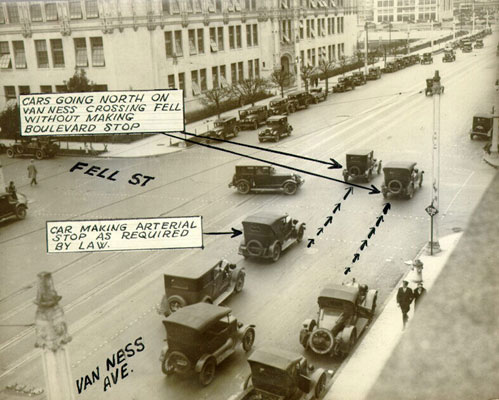 Newspaper photos campaigned to educate citizens about "proper use" of the streets, increasingly dedicated to private automobiles.
Newspaper photos campaigned to educate citizens about "proper use" of the streets, increasingly dedicated to private automobiles.
When a business slump hit in 1923-24 and car sales plummeted, the press speculated that the market for private automobiles was already “saturated”. The car industry cleverly redefined ‘saturation’ from the market to the street. They claimed that the so-called “saturation” was a problem of space, and that the solution was to re-design streets and cities to accommodate many more cars.
"Jaywalkers" cross against signal at 5th and Market, San Francisco, 1942.
As late as the mid-1920s there was a wide consensus to control cars, slow them down, subordinate them to other uses. Over 70% of urban commuters used streetcars while only 11% used cars in San Francisco. The same 1927 San Francisco traffic study showed that one-third of 1.1 million daily commuters into the downtown area arrived on foot …
By the end of the decade the story had completely changed. During the years from 1924-1930, national business leaders had created new associations, with the full support of the government, which shifted the discussion by appealing to American individualism and patriotic appeals to freedom to gain the upper hand. The streets of America, which had been seen as public utilities that should be regulated for the common good, were reconceptualized as “products” that could be purchased by the motorists paying gasoline taxes. Traffic engineers were no longer tasked with designing streets to serve the most people most efficiently. Instead, they were to respond to market “demand” as exemplified by private car owners who supported the redesign of cities to accommodate wider streets and ample parking lots.
By the 1930s the new organization of urban life was taking shape. Cities everywhere were widening streets, building wide boulevards, increasing curb parking, and altering the rules of the road to restrict pedestrians and give more rights and space to cars. Separated, elevated freeways were the vision of the future, but it would take some years before they began to build them all over the country.
Black dotted lines on sidewalks indicate where they would soon be narrowed to make more room for cars in this 1939 photo of Capp Street in San Francisco.
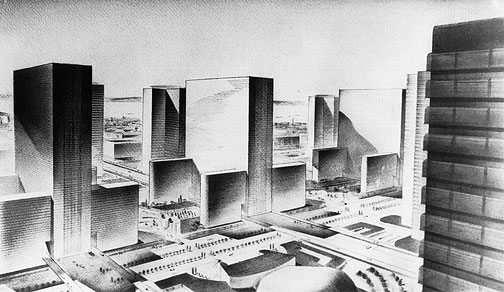 In the 1939 Golden Gate Int'l. Exposition (Treasure Island World's Fair) this grim image of 7th and Howard is meant to show San Francisco in 1999!
In the 1939 Golden Gate Int'l. Exposition (Treasure Island World's Fair) this grim image of 7th and Howard is meant to show San Francisco in 1999!
After WWII, in the United States a massive federal program built the interstate highway system, a series of freeways that crisscrossed the country many times over east-west and north-south, with ring roads around every major urban center. Streetcar systems which had been going bankrupt since the 1920s finally were municipalized and often modernized with buses replacing streetcars. The conversion of U.S. life to fully auto-centric was nearly complete by the late 1950s.
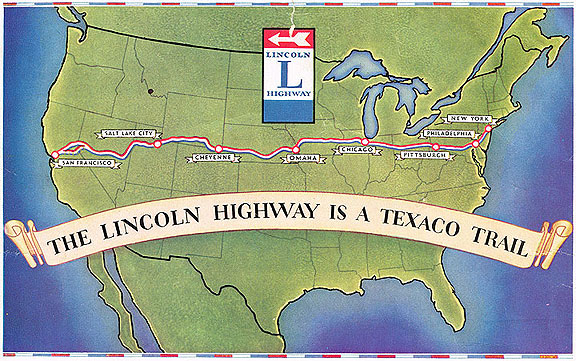 The first transcontinental paved road in the U.S. finished well before WWII was dubbed the "Lincoln Highway," here used to advertise a brand of gasoline.
The first transcontinental paved road in the U.S. finished well before WWII was dubbed the "Lincoln Highway," here used to advertise a brand of gasoline.
The U.S. was the overwhelming dominant power in the world during this same era, a period when countries were ranked as “developed” or “developing” and if in the latter category (as Mexico and all of South America was) it was considered urgent to adopt the patterns of growth that had been pioneered by the U.S. Car manufacturing emerged in Europe in the 1950s and 1960s, in Mexico and Brazil by the 1970s, and in Asia by the 1980s. The so-called “world car,” assembled in factories across the planet, became the norm in the 1980s too, and everywhere national economies turned to the private car as the literal motor of domestic development.
The triumph of the car and the full conversion of urban life to revolve around private automobiles is the story of the 20th century. But it was also in the 20th century specifically in the late 1950s and 1960s that citizens in some places, notably New York, Boston, and San Francisco, organized to stop the onslaught of freeway building that was destroying their city’s neighborhoods.
Freeway revolt in SF
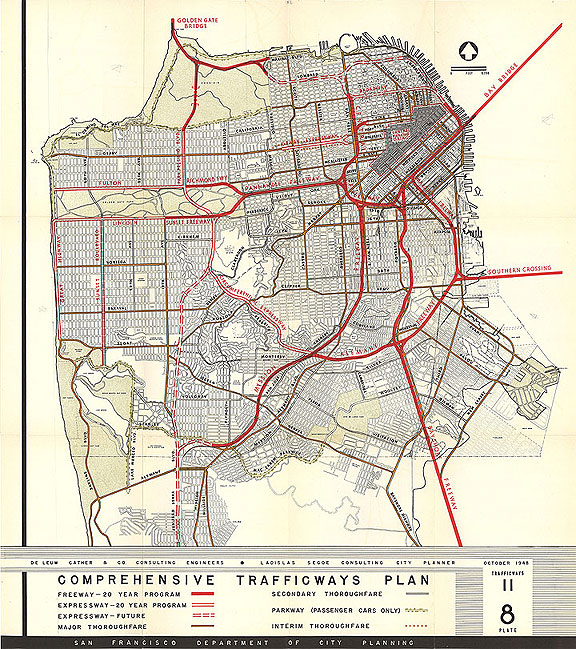 1948 trafficways plan for San Francisco, with plans for freeways crisscrossing the city and destroying many of its best neighborhoods.
1948 trafficways plan for San Francisco, with plans for freeways crisscrossing the city and destroying many of its best neighborhoods.
On November 2, 1956 the San Francisco Chronicle graciously published a map of the proposed and actual freeway routes through San Francisco even though its accompanying editorial was already chastising protestors:
“The remarkable aspect of these protests and claims of injury is their tardiness. They concern projects that have for years been set forth in master plans, surveys and expensive traffic studies. They have been ignored or overlooked by citizens and public official alike—until the time was at hand for concrete pouring and when revision had become either impossible or extremely costly. The evidence indicates that the citizenry never did know or had forgotten what freeways the planners had in mind for them.”
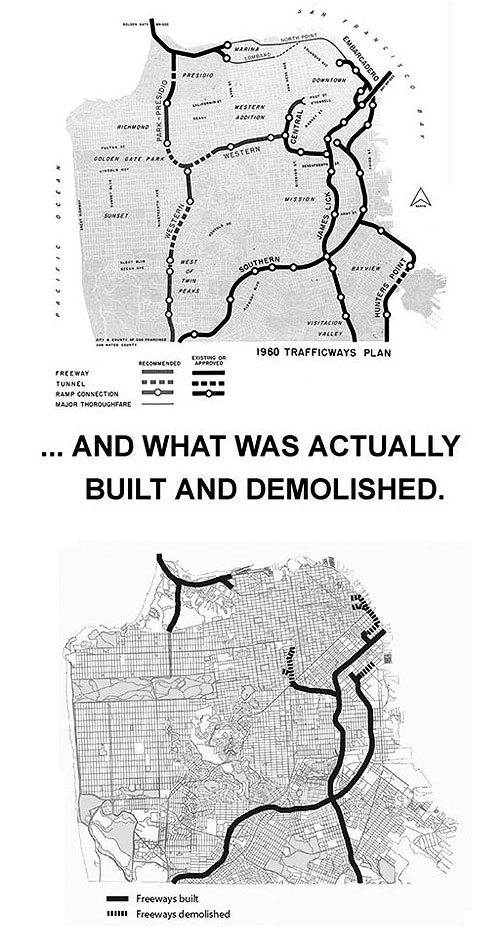 Top image shows the final plans to complete crosstown freeways in San Francisco around 1960, but the bottom map shows what was finally completed (including the dotted sections of freeways that were destroyed after the 1989 earthquake).
Top image shows the final plans to complete crosstown freeways in San Francisco around 1960, but the bottom map shows what was finally completed (including the dotted sections of freeways that were destroyed after the 1989 earthquake).
Just three years earlier San Francisco had opened its first section of freeway. On October 1, 1953 the Bayshore Freeway opened and San Franciscans could now drive three unmolested miles of “divided no-stop freeways” from Alemany to Bryant. But as the plans unfolded, public opposition grew. By the time the Embarcadero Freeway along the city’s waterfront was under construction in 1958, a loud opposition had formed, going on to campaign for its removal after its completion. Over 30,000 people signed petitions at meetings organized in a half dozen neighborhoods. In 1959 the city government voted to cancel 7 of 10 planned freeway routes through the city, much to the shock of the California Department of Highways and the federal government. But that was not the end of the freeway revolt.
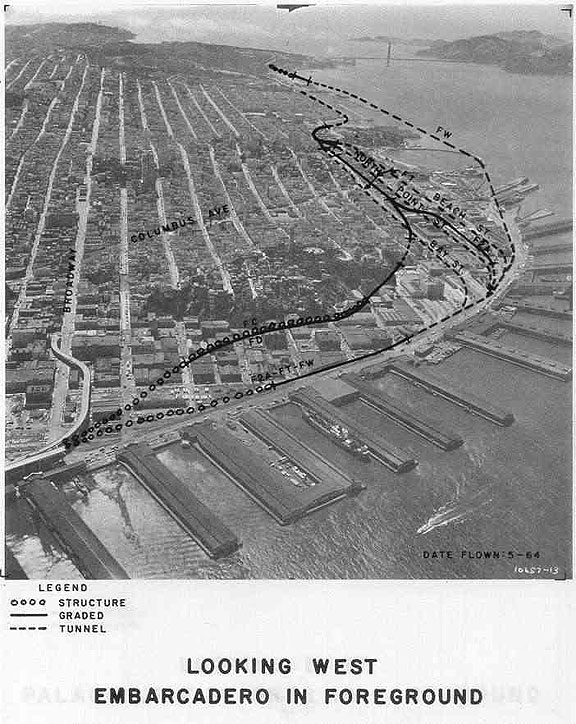 Some of the proposed extensions for the double-decker freeway to connect the Embarcadero with the Golden Gate Bridge (note the unfinished Embarcadero Freeway at lower left).
Some of the proposed extensions for the double-decker freeway to connect the Embarcadero with the Golden Gate Bridge (note the unfinished Embarcadero Freeway at lower left).
Freeway protesters march along waterfront with unfinished Embarcadero Freeway behind them. In distance is Ferry Building where it was walled off by the double-decker freeway.
Freeway builders continued to resurrect various routes, encountering persistent, well-organized resistance by San Francisco neighborhoods. In 1964 the battle came to a climax over the Panhandle-Golden Gate Park Freeway plan, with a May 17 rally to save the Park. Months later, in a final, climactic 6-5 vote, the Board of Supervisors rejected the Park Freeway on October 13. The only African American Supervisor, Terry Francois, cast the deciding vote, delivering a point-by-point six-page rebuttal to the pro-freeway arguments. The Supervisors’ Transportation Committee had received a petition with 15,000 signatures, 20,000 letters and telegrams, and had received opposition from 77 community organizations.
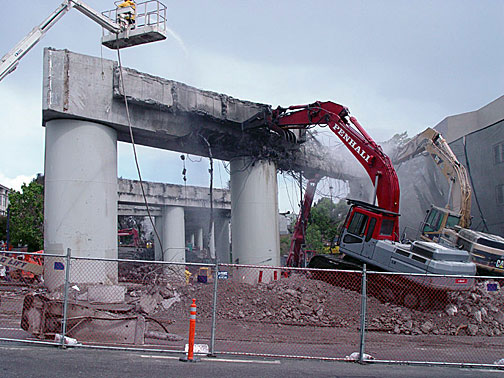 Taking down the freeway north of Market Street in early 2000s.
Taking down the freeway north of Market Street in early 2000s.
Today, San Francisco’s freeways have changed again, thanks to the Loma Prieta 1989 earthquake. The much maligned Embarcadero Freeway has been removed. A raging debate over the future of the Central Freeway ramps that went north across Market was finally resolved and they were replaced by the surface Octavia Boulevard. New offramps were added to a freeway to serve a new waterfront roadway and the new baseball stadium in 1997, but no new freeways will be built in San Francisco. The rapid rise in value in both areas where freeways were removed, along the now open waterfront, as well as the rapidly gentrifying Hayes Valley/Civic Center area, show that profits can be drawn from forward looking urban planning, de-emphasizing cars and re-emphasizing neighborhood, community, and nature. We even have a new urban farm on former on- and off-ramps.
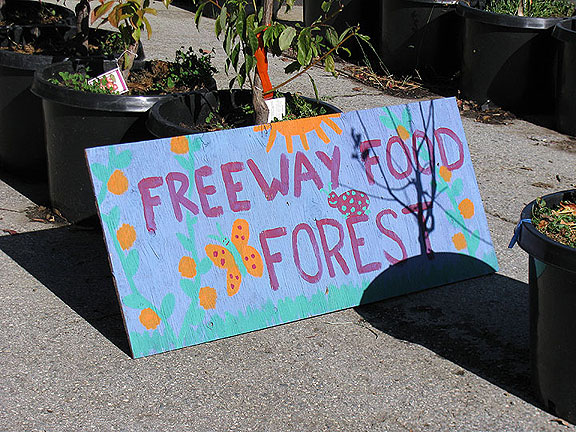 The Hayes Valley Farm was started on the former on- and off-ramps of the Central Freeway.
The Hayes Valley Farm was started on the former on- and off-ramps of the Central Freeway.
Freeway Revolts in Guadalajara and Vancouver
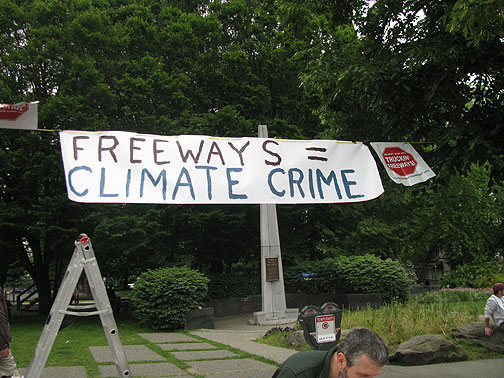 Vancouver's "Gateway Sucks" campaign, which gave rise to the Car-Free Vancouver Day, going on 7 years now.
Vancouver's "Gateway Sucks" campaign, which gave rise to the Car-Free Vancouver Day, going on 7 years now.
Car-Free Vancouver Day started seven years ago as a part of the years-long campaign to stop a $10 billion freeway and port expansion plan that will bulldoze local farms, neighborhoods, and indigenous sites, in addition to wrecking a couple of extant urban wilderness zones at Burns Bog and Surrey Bend. The “Gateway Sucks” campaign emphasizes that this plan, which is still proceeding, will lock in more urban sprawl and sabotage the local greenhouse gas reduction plan, all to increase trade in raw goods and disposable junk.
The East Vancouver neighborhood was the first to propose a day-long closure of the its main corridor Commercial Drive as a way to demonstrate popular opposition to further freeway building. Car-Free Vancouver Day has grown to encompass five separate neighborhood street closures in different parts of the city, and is a product of grassroots organizing, with hundreds of volunteers working hard for months to produce an exciting day of urban reinhabitation.
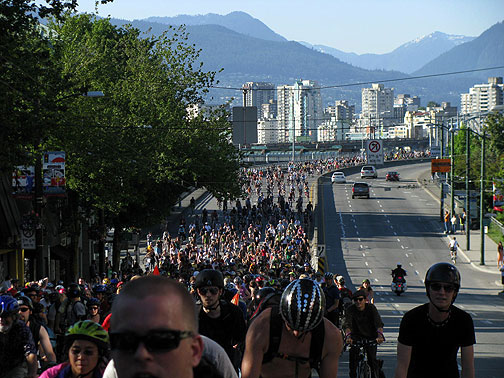 Vancouver's Critical Mass has been a big contributor to the shifting values of that northwestern city.
Vancouver's Critical Mass has been a big contributor to the shifting values of that northwestern city.
On a visit here in December 2010 to Guadalajara, I had the pleasure of discovering a vibrant grassroots movement to block the construction of a new 23-kilometer elevated freeway through the heart of the city.
 The anti-freeway campaign in Guadalajara.
The anti-freeway campaign in Guadalajara.
This movement leaned primarily on people who live along the proposed route of the freeway, but found crucial support and activism from Ciudad Para Todos (City For All), a three-year-old group of bicycle and transit activists who are Guadalajara’s most vocal opponents to the reign of the car.
A few months ago the campaign achieved its first success when the freeway plans were scrapped. Compared to San Francisco’s decades-long freeway revolts, or Vancouver’s still-going campaign to halt the Gateway project, Guadalajara is an inspiring success story that happened in less than one year! (Though it is not over yet, with possibilities of the plan being resuscitated after next year’s election, so the movement must keep going.)
In June 2010, just before our hosts this year left for York, England for last year’s Car-Free Cities Conference, the Jalisco State Government published a video online describing the new freeway (La Via Express) plan. The Jalisco state government (which encompasses the city of Guadalajara) declared its intention to build a freeway on the same railroad line that a previous city government had proposed for a linear park and garden corridor with bicycle and pedestrian zones. The corridor conveniently cuts through the city and is used by laborers riding bicycles 20-30 kilometers a day between home and work.
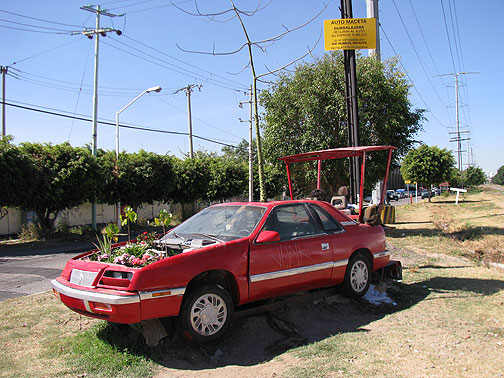 This car was installed along the proposed route as part of the protests…
This car was installed along the proposed route as part of the protests…
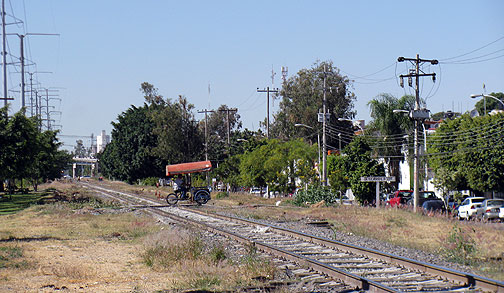 Pedicab vendor crosses tracks that would all be destroyed by the proposed freeway.
Pedicab vendor crosses tracks that would all be destroyed by the proposed freeway.
The Guadalajara activists brought the government video with them to England and showed it to the gathered planners and activists on the first day (maybe some of you remember?) and made two guerrilla video responses. The guerrilla videos made by Ciudad Para Todos quickly began to circulate and galvanized local opponents, but neighbors of the proposed Expressway had already begun organizing before they even saw the video. During our December visit we met Dr. Alicia Jaik, an energetic former medical doctor, now running a small corner store along the proposed route. Her neighbor is a local politician and when he asked her what she thought of the proposal she declared her dismay. “What should we do?” asked the politician. “Get to work!” was her immediate response. Signs sprung up along the houses up and down the street.
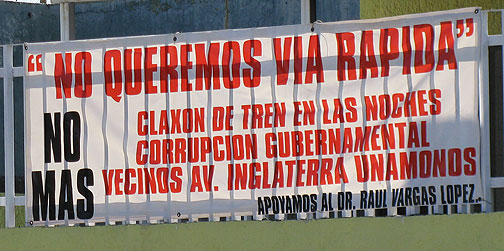 Neighbors oppose freeway along Avenida Inglaterra.
Neighbors oppose freeway along Avenida Inglaterra.
A short time later Étienne von Bertrab was walking along the rail line with a local journalist and was thrilled when he saw the signs. With the journalist in tow, he knocked on Dr. Alicia’s door and after realizing they had much to discuss, he was invited to a meeting called a few days later. At the meeting Etienne and his colleagues presented their videos, their larger critique, and the plans that had been created by the previous municipal government for a linear park. They were met with great enthusiasm. “What can we do? When can we start? Can we do it this Saturday?” demanded the neighbors. Nobody anticipated an action plan emerging so quickly, but they saw a good thing when it appeared. “Why not?”
That Saturday was the first gardening party, beginning with the removal of tons of accumulated trash. From that July meeting regular Saturday work parties kept happening. There are now hundreds of new trees planted and at least eight different neighborhood associations involved. Neighbors have established new relationships with each other, and public feasts have become a regular feature of the Saturday work parties and other days.
At a nearby university campus students have been eager participants as well. Painstaking work with local businesses gained further support, many of them angered by the backroom dealing going on with big connected Mexican companies ICA, Cemex, and Grupo Mexico. A press conference of two local business associations was held on December 2 supporting demands for more transparency, public hearings, and technical evaluations of the freeway plans before anything begins. Meanwhile, the facts on the ground were getting better every weekend.
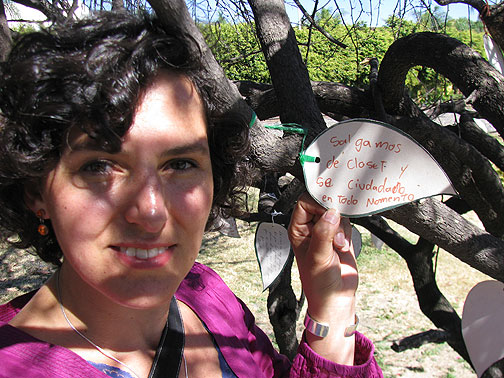 One of the leaves hanging on the tree in the park…
One of the leaves hanging on the tree in the park…
The down-to-earth politics of this already successful Freeway Revolt in Mexico are a shining example to climate change activists everywhere. As Dr. Alicia put it to us, “Aqui, nadie es nadie, todos somos todos.” (Roughly translated as “Here, nobody’s a bigshot, we’re all in it together.”) She was emphasizing that they weren’t relying on the political parties or their representatives, to the contrary, they were disallowed in this campaign. Our friends in Ciudad Para Todos underlined the same point: The local diputado (elected representative in the state government) could participate as a citizen, but they wouldn’t support his offer to bring in work crews, equipment, and resources, whereby his political party would colonize the effort for their own ends. Dr. Alicia told us, “Before neighbors wouldn’t really talk to each other. Now we’re a community!”
A dead tree across from her small store had come back to life with several dozen fluttering hand-written “leaves.” One of our favorites said “Leave the closet and let’s be citizens all the time.” It’s just such a reinvigorated—and visionary—citizenship that is the foundation of the transition that we must make in the face of Climate Chaos, the Energy and Economic Crises, and the generally dissatisfying daily lives we lead in the second decade of the 21st century.
As we discuss the seemingly unrealistic idea of “car-free cities” it helps to remember the rich history that we are already living. Streets have not always been controlled and dominated by car industries. Private cars are a disaster for human and non-human life, and it’s high time we reconnect to the long history that has been resisting this monster. Life was very different before the car and it will be very different AFTER the car too!


